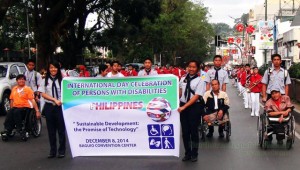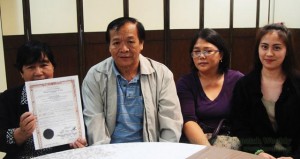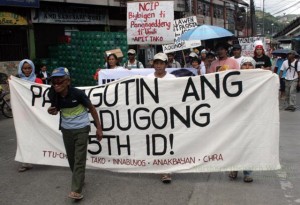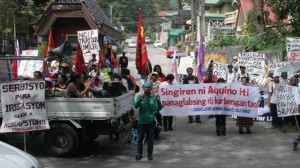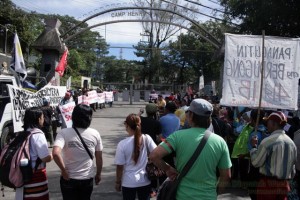 |
| Underground wonder Photo by Aldwin Quitasol |
Sagada’s Balangagan Cave, an underground wonder & ancient burial ground
Published by the Northern Dispatch Weekly November 16, 2014
The genesis is from a folk tale passed on by elders. A long time ago, three men from Taccong, Sagada went for
kupiti (bat) hunting inside a
liyang
(cave) caught quite a fortune – lot of bats. On their exit, they had
difficulty finding the way out. They got tired, confused, and fear took
over them as it seemed they kept ending up in the same area of the
liyang.
They heard a voice of a spirit dwelling in the cave. It told them not
to take out dwellers (the bats) or anything from the cave. Immediately,
the three men Bangcawayan, Lawagan and Nagayang freed all the bats they
caught. Then they followed the same path they took and came out alive
from the
liyang.
Lakay (elder) Julio Mani of Taccong retold this tale on Wednesday’s
inauguration of the Balangagan Cave to serve as a reminder, “while we
open the cave for visits to tourists and locals, nothing should be taken
out from the cave,” he told the crowd of representatives from different
agencies, officials, media and villagers.
From the tale, it was learned that the liyang was named after as
Balangagan, coined from the names of the three lost villagers inside the
cave, and, perhaps, an eternal reminder for visitors to observe their
indigenous concept of inayan or lawa, leave the things as they are
sacred to the area.
 |
| Balangagan Cave inauguration. Photo Art Allad-iw |
Balangagan is located in the hilly and pine tree covered barangay of
Taccong and Suyo, Sagada, Mountain Province. It is more or less three
kilometers from Poblacion. Sagada is more or less 130 kilometers and a
four to five hour drive – on the improved Halsema Highway – from Baguio
City.
It is a unique wonder, natural underground environment of various
rock formations and century-old burial grounds of the ancestors of the
indigenous peoples in the area. Such complimented Sagada as Shangrila of
the north due to its waterfalls, lake, pristine pine-clad mountains,
and wonderful underground caves that offer natural attractions to
spelunkers and nature lovers.
 |
| Blue-watered natural pool. Photo Art Allad-iw |
Natural wonder
Near the entrance of Balangagan is an eye-catching blue-water natural
pool, where guides claim turns to green during rainy season. Flowing
crystal clear streams seem to lead vistors into the cave.
Stalactites and stalagmites, in various forms and sizes, will
definitely glue the eyes of adventurers to the roof from the entrance to
inside the cave. “Its colorful speleothems are studded with sparkles
that glint when lighted,” Robert Pangod, the municipal tourism officer
said. Like the Sumaging cave of the town, these natural formations at
the Balangagan cave are beyond description but best appreciated only
when personally seen.
 |
| Cave entrance. Photo by Art Allad-iw |
Cavers are cautioned, too, in exploring the winding hollows as there
are low ceilings and passages that are tight and slippery. As such,
cavers are advised to use appropriate footwear, and must visit the area
with the assistance of professional guides provided when visitors
register at the Poblacion.
Cavers would be amused with cathedral wide spaces inside complimented
by the echoing din of bat sounds, the only music one may hear. And, the
bats’ guano, evidence that the area had been closed for a long time, as
one would have his foot covered up to his knee from the substance.
 |
| Rock formations. Photo by Art Allad-iw |
Sacred burial ground
Balangagan’s natural wonders are complimented by the rich heritage of
the indigenous people in the area. It is a sacred burial ground where
various coffins were either tucked in high above on the ceiling, hanging
coffins, or piled one coffin on top another. Their dead at the
Balangagan Cave were placed in hollowed tree trunks and in jars, elders
added. And they added that the cave’s twilight zone was an ideal resting
place for their departed. “It is sacred that we are morally bound to
protect,” explained Lakay Mani.
While amazed by how the coffins were kept inside, there are various questions that arise.
 |
| One of the rock formations. Photo by Aldwin Quitasol |
At the height of a three storey building, there were coffins – both
jars and hollowed tree trunks. There was no evidence insight of how they
did it or any evidence of support materials in the area that they may
have used to reach such height.
“How did the earlier ancestors place the coffins at that height? How
old are these jars used as coffins?,” were among the questions raised by
Larry Fabian, a journalist based in Baguio City. The questions may be
answered by anthropologists who may have studied these ancient
practices, as the elders had no documented literature to aid answers for
the questions raised.
 |
| Photo by Aldwin Quitasol |
Marcos Cave
The wonders of Balangagan captivated officials of the then President
Fedinand Marcos administration. Then provincial Governor Alfredo Lam-en
facilitated the development of Sagada as tourist destination. Through
the Ministry of Tourism headed by Jose Aspiras, Lamen facilitated a road
to Taccong and opened the cave to the public. In return, it was through
him that the cave was named Marcos Cave, a chamber named Imelda, the
wife, and the hall, as Aspiras hall, all directed for a development of
the area as tourist attraction.
The development stopped during the tumultuous years of Marcos until he was removed from power via the Peoples Power Revolution.
But the cave named after Marcos, his wife and crony, was not
acceptable to the people, ever since it was coined in the 80s. Hence
villagers still call it Balangagan cave.
Reopening of Balangagan
The reopening of the cave is a move by the southern barangays of
Sagada, namely Taccong, Suyo, Nacagang and Ankileng. They favor the
opening of the cave which would be integrated to the town’s plan but,
importantly, a community-based tourism program where they will have a
greater role in the development and management. “This community-based
tourism program will be ensured by our municipality, particularly the
culture of the umili (villagers) of respecting the sacredness of the
place,” assured Mayor Eduardo Latawan Jr., as they will adopt more
measures to ensure that the coffins inside will be protected from
deterioration and vandalism.
Accessibility, too, is addressed as the Balili-Payag-eo-Suyo road is
on-going as a priority project funded by the DPWH-DOT convergence
program.
 |
| Road development for easier access to the cave. Photo Art Allad-iw |
Such accessibility is seen by the municipal government as a step to
easily supervise the area and arrest from defacement. Vandalism,
destructions of the stalactites and stalagmites, desecration of the
coffins and the remains had been noted earlier in the cave. With such
accessibility and municipality’s adoption of management plan,
stakeholders believed that Balangagan can be maintained at its present
state.
But the words of Lakay Mani that reverberates must be incorporated in
the plan, “nothing should be taken out from the cave as it is a sacred
ground. We are willing to share the appreciation of this natural and
cultural heritage to visitors who can freely visit the area. A must,
however, is the respect of our system – that the area is a resting place
of our departed ancestors. We are morally bound to protect its
sacredness.” #
nordis.net


